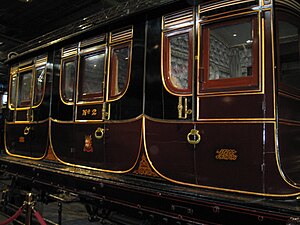Queen Adelaide Parlor Car
| Queen Adelaide Parlor Car | |
|---|---|
| Number: | 1 |
| Year of construction (s): | 1842 |
| Retirement: | 1850? |
| Axis formula : | 2 |
| Gauge : | 1435 mm ( standard gauge ) |
| Brake: | no |
| Seats: | 2½ compartments with a total of 9 seats |
| Standing room: | 1 bed |
The lounge car of the Queen Adelaide is the oldest saloon car in the world. It is now in the National Railway Museum in York .
history
Adelheid ( Anglicised : Adelaide ) Louise Theresa Caroline Amelia von Sachsen-Meiningen (1792–1849) was the wife of Wilhelm IV (1765–1837), from 1830 to 1837 King of Great Britain and Ireland and Hanover . Under the reign of her husband, the new means of transport, the railroad, enjoyed rapid growth. Great Britain was a world leader in this sector.
The car was built for the London and Birmingham Railway in 1842 , the same year that Queen Victoria first confided in the railroad on June 13, 1842. The chassis and the frame of the car were made in the workshops of the railway company in Euston , but the car body was made by a workshop that had previously made carriages . The vehicle was named "No. 2 ”. Queen widow Adelaide probably used the car until her death in 1849. The vehicle is said to have served as a model for other royal saloon cars in Europe.
The car was understood quite early on as a historical testimony to the development of the railway and was preserved as a museum . It was first exhibited in 1904 at the World Exhibition in St. Louis . King George V and Queen Mary toured the car during their visit to the central workshop of the London and North Western Railway on April 21, 1913 in Crewe . It was parked there at the time. The vehicle is presented today at the National Railway Museum in York along with other saloon cars of the British royal family.
description
The two-axle car is a typical vehicle from the early days of the railroad and very similar to a 1st class passenger car of that time. The structure consists of two and a half carriage boxes that are mounted together. The result was a compartment car with two full compartments and one half compartment. The full compartments each have three seats arranged opposite one another, the half compartment only has one row of them. On the outer full compartment there was a " post box" typical of stagecoaches , a storage space to accommodate mailbags. In contrast to a stagecoach, the box was open to the compartment. When the seats were in the daytime position, the opening was covered by the backrest of one of the bench seats. For the night position, a cushion was inserted between the opposite seats and the backrest folded away. The extra space in the "post box" gave the feet enough space for Queen Adelaide to sleep in the stretched position. The vehicle was illuminated with two oil lamps . The sleeping compartment had one, the other full compartment and the half compartment shared one.
Web links
- Depiction on the homepage of the National Railway Museum in York, England.
literature
- Paul Dost: The red carpet. History of State Trains and Salon Cars. Stuttgart 1965.
- Patrick Kingston: Royal Trains . London 1985. ISBN 0-7153-8594-1
Remarks
- ↑ Inventory number: 1983-7001.
Individual evidence
- ↑ Dost, p. 189; Kingston, p. 19.
- ^ Homepage of the National Railway Museum.
- ↑ Dost, p. 189.
- ↑ Ursula Bartelsheim: Versailles on Wheels - Ludwig II and his court train. (Object stories from the DB Museum 1). Nuremberg 2009, ISBN 978-3-9807652-5-1 , p. 7.
- ^ Dost, p. 190.
- ↑ Kingston, p. 67.
- ^ Homepage of the National Railway Museum.
- ↑ Kingston, p. 120.
- ↑ Kingston, p. 121.
